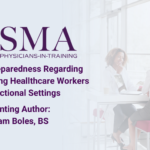Abstract | May 3, 2021
Perceived Preparedness Regarding COVID-19 among Heallthcare Workers in Correctional Settings
Learning Objectives
- To name at least 3 ways in which HCWs who work in jails felt worse-prepared for handling COVID-19 compared to other correctional facilities;
- To name at least 2 ways in which HCWs who work in juvenile detention centers felt better-prepared than other facility types to handle COVID-19;
- To identify how many weeks after their facility had its first COVID-19 patient most correctional HCWs reported that it took until adequate protocols were in place for COVID-19 patient care and adequate PPE was available to them.
Background:
Healthcare workers (HCWs) in correctional settings play a particularly important and challenging role in addressing the COVID-19 pandemic: U.S. jail and prison populations are especially vulnerable to the effects of COVID-19; there are significant obstacles to infection prevention and control in correctional settings; and correctional facilities in the U.S. have already become home to the country’s largest outbreaks. However, capturing an accurate picture of this population can be difficult due to a lack of uniformity in how correctional HCWs are hired. Facilities may hire their HCWs through their state’s Department of Corrections; through a private contract firm; or use a mixed model to serve their incarcerated populations. Furthermore, any individual correctional HCW may regularly work at one facility, or work at a variety of facilities. Now, in the context of the COVID-19 pandemic, evaluating different areas of perceived preparedness such as knowledge, attitudes, expectations, and access among correctional HCWs is critical as it will not only speak to the psychological wellbeing of our correctional healthcare workforce, but also reflects practice through social cognitive theory.
Methods:
The one-time, self-administered survey through Qualtrics collected data utilizing an abbreviated and modified version of the World Health Organization’s (WHO) Perceptions of Healthcare Workers regarding local infection prevention and control procedures for COVID-19 survey. It also collected basic non-identifiable demographic data (ie. age, state, ETC ETC) and information on the facility type, operating entity, and security level of the correctional facility. Survey questionnaires were distributed through paid e-newsletter advertisements and social media posts with the National Commission of Correctional Healthcare (NCCHC) in September and October 2020 to people who provided direct patient care since January 2020 for at least one month in a prison, jail, detention center, or juvenile detention center. In total, n=932 responses were collected from healthcare workers throughout the nation who work in correctional settings. Chi-square tests and ordinal logistic regression were used in analysis to determine associations between facility type and perceived preparedness variables.
Results:
Preliminary results indicate that correctional healthcare workers with the lowest levels of perceived preparedness for COVID-19 were significantly more likely to have worked in a jail than other correctional settings. Further analysis is in progress.
Conclusions/Implications:
The implications of this study will point out which areas of perceived preparedness, such as knowledge, attitudes, and environmental resources, may be weakest among correctional HCWs. It may also demonstrate that some correctional facility type’s HCWs feel significantly less prepared than others for COVID-19.

